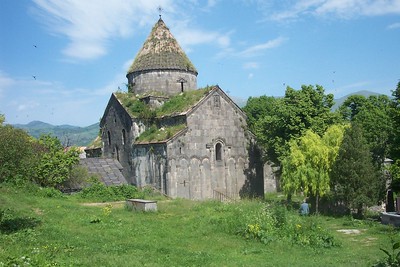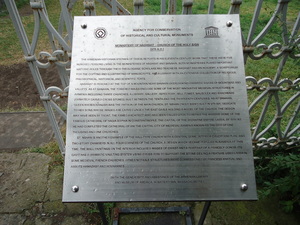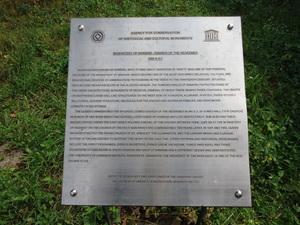Haghpat and Sanahin

The Monasteries of Haghpat and Sanahin represent a fusion of Byzantine ecclesiastical architecture and vernacular architecture of the Caucasus.
These monasteries dating to the 10th-13th centuries are located in the Debed Canyon in harmony with their picturesque landscape. Both compounds contain several historic churches. Sanahin also has over 50 ancient khachkars (sculptured cross-stones) standing on its territory.
Community Perspective: These are located not far from each other in a fine setting, if you think away the industrial town of Alaverdi. The khachkars are of particular interest. See Nan’s review for tips on getting there without a car.
Map of Haghpat and Sanahin
Community Reviews
Nan

As a stopover between Tblisi and Dilijan and Yerevan, we visited Haghpat monastery and Sanahin Bridge. Both are medieval monuments (10-12th century) belonging to the Kingdom of Lori, a 10th century offshoot of the Kingdom of Armenia. The key element is the unique masonry, that also sets it apart from Georgian churches of the same period.
Our plan had been to first visit Akhtala (not on the list), then Haghpat, then Sanahin and continue towards Dilijan for the night. However, when we came back to our car after our visit of Haghpat, we noticed our driver, as he was checking the tires. Both tires on the left side of the car were broken; we must have hit something along the way. We exchanged one with the spare tire, descended from Haghpat and made it back to Alawerdi safely were the driver left us to get two new tires. Upside: We had ample time to explore the Sanahin bridge (which takes 5min).
After spending an hour waiting for our driver and new tires and with the weather turning bad quickly (heavy rains!), we decided to skip on Sanahin and head directly to Dilijan for the night.
Haghpat and Sanahin are probably the best WHS you can visit in Armenia. They combine the usual Armenian church look and feel with great masonry and the natural beauty of the valley. They are no longer, though, hidden gems. Unlike Paul, we saw loads of tour buses at Haghpat.
Getting There
Broadly speaking, you have two options. The easiest option is to join an organised tour from either Tbilisi or Yerevan. Due to the border crossing, the Tbilisi option is likely to be more expensive. Time wise it should be about the same as Tbilisi is closer, the sites being just behind the border.
If you want to get there on your own, you can take a marshrutka (minibus) that runs between Tblisi and Yerevan and get off at Alawerdi. This is the first/last stop in Armenia, just ping the driver when you get on the bus (1) and when you reach Alawerdi (2). In Tblisi, the departure point is near Avlabari station (aptly labelled "Bus to Yerewan" on google maps) and you can (and should) reserve via whatsapp. The contact details are in the photos of the place on google maps. In Alawerdi, you can walk to the Sanahin Bridge and visit the Sanahin Monastery by marshrutka. There is also a hiking trail funded by Germany. Note that Sanahin Monastery is on a hill, while Alawerdi is in the river valley and the climb is steep.
To get to Haghpat you can take a taxi. The fare should be 5,000 drams to see both Hagphat and Akhtala Monastery (100 drams/km). We added a transfer from Alawerdi to Dilijan and paid 15,000 drams for the whole trip.
While You Are There
Debed Canyon was our highlight in Armenia. Apart from the two inscribed churches, there are several other churches to visit: Akhtala Monastery, Odzun Church and Kobayr Church. The Akhtala Monastery is not to be missed for its magnificent frescoes. In addition, you can explore Lori castle, the old capital. I would actually like to see the site expanded to include more sites in the Canyon: Churches of the Debed Canyon or Sites of the Lori Kingdom.
For fans of lost places, the Debed Canyon is also worth a visit on its own. The Soviets heavily industrialised the valley and there are ruins of large factories and abandoned lifts all over the place. Sanahin is also home to the Mikhoyan Museum, dedicated to the builders of the MiG fighter jets.
If you can make it, stay overnight. But be aware that the local hotels are very basic. That's why we decided to stay overnight in Dilijan instead.
Sophie

The Byzantine monastery of Haghpat was an important centre of learning in medieval times and is an excellent example of Armenian religious architecture. Haghpat and Sanahin together form one of Armenia’s three UNESCO World Heritage sites. Like Haghpat, Sanahin was a place of study, particularly famous for illumination and calligraphy.
Though what intrigues me even more are grave stones. In Armenia, there’s frequently a photo of the deceased on the grave stone. Not that unusual in itself – but it’s also not uncommon to illustrate how they died. I stand for a long time in front of a stone, engraved with the image of a man and three women, one of them a young teenager at most. Next to the happy group is a car driving off a cliff. Evocative. And sad. Also, I’m reminded of the narrow roads back down the mountain, and shiver.
Read more from Sophie here.
Els Slots

These are two of the many monasteries / churches in the Debed Valley that I saw on a day trip from Vanadzor. I had rented a taxi to take me there and was transported like a royal (in the backseat of an authentic Volga). After an hour or so, our first stop was Sanahin. This monastery is situated on a hilltop in the outskirts of Alaverdi. Amidst the apartment buildings, it wasn't easy to find. Up and close however it's a fine sight in a tranquil environment. The friendly lady with the key showed us around, explaining every detail to the driver (me not understanding a word because of a huge Armenian-Dutch language barrier, both sides were used to a different lingua franca (Russian-English)). Like so many other Armenian churches, this one is also blackened inside from fires.
Haghpat monastery is on the other side of Alaverdi. It's more of a landmark than Sanahin, but I wouldn't want to choose between them. Its church holds a faded fresco of Christ above the altar. Both Haghpat and Sanahin are large complexes, that host facilities like a library, a dinner hall e.a. Khatchkars can also be found, not all in very good condition. The Haghpat complex is partly overgrown by grass and flowers, a treat to the eye in springtime.
On our way back the driver Valera invited me into his home in Alaverdi and meet his family. They were a bit surprised of course, to find a turista on their doorstep. I was fed cookies and ice cream and took a picture of the whole beaming family in return. To see how this family lives, in a crumbling Soviet-apartment block close to the huge Alaverdi mine, really was an eye-opener. Their living conditions to an outsider look saddening, but inside the four walls of the family apartment all seemed pleasant enough. Because of the hospitality I experienced here, this one has become a truly memorable visited WHS.
Solivagant

These 2 monasteries are linked together in the same WHS both because of their geographic proximity and their commonality of architectural design. We had both monasteries completely to ourselves. Our trip was taking us to Georgia and a visit to this WHS fits in well with the route from Yerevan to the Georgian frontier
Sanahin sits high above the industrial town of Alaverdi, a “Soviet” city built in a deep valley on 2 levels joined by a road and cable car. When we were there in August 2000 the city appeared to be suffering from the total run down of its industrial base and gave off a depressing air with its badly built Soviet apartments showing huge cracks in their walls perhaps dating back to the earthquake of 1988! It is set deep in the mountains towards the Georgian border and one wondered what economic logic there could be under a capitalist system for an industrial centre there. In the churchyard modern graves showed that the church was in use and, in a style we had come to recognise in Russia, were marked by finely etched pictures on stone depicting the deceased and often their circumstances of death. One I remember showed graphically the death of a whole family as their car careered off a mountain road!
Hagphat is a few miles further on in more rural surroundings and is perhaps the more pleasing of the 2. Both are quintessentially “Armenian” – with an atmosphere very different from Catholic or Orthodox monasteries and which needs to be experienced to be understood. The “Khatchkars” are a particularly noteworthy feature – uniquely Armenian carved crosses which act as gravestones or memorials and which crowd upon each other on walls and in the churchyard. Neither site, however, approaches the scenic grandeur of the Sevan Monastery which is beautifully situated on a lakeside and often figures in tourist brochures and posters for Armenia. But for some reason that is not a WHS!
Community Rating
- : Milan Jirasek Marty Walter WalGra Roman Raab Mikita M Fmaiolo@yahoo.com
- : Tony H. RobRos Christoph Kevin McFarland Alexander Lehmann
- : BH Aljaz Hanming Dutchnick CHJLondon Vernon Prieto Sophie Alex Els Slots Ljowers Kevin247 Alexander Barabanov GerhardM Christravelblog Kurt Lauer
- : Merveil JLuth Luke LOU Mahuhe Juha Sjoeblom Thomas van der Walt David Berlanda Philipp Leu Szucs Tamas Stanislaw Warwas CugelVance John Smaranda
- : Kristin Tingmelvin Afshin Iranpour Martina Rúčková Nan Ivan Rucek Yevhen Ivanovych
- : Stanimir Solivagant
- : Zoë Sheng
- : Lukasz Palczewski
Site Info
Site History
2000 Extended
To include Sanahin monastery
1996 Inscribed
Site Links
Unesco Website
Official Website
Related
In the News
Connections
The site has 14 connections
Art and Architecture
Constructions
Damaged
Geography
History
Religion and Belief
Science and Technology
Timeline
World Heritage Process
Visitors
186 Community Members have visited.
The Plaque
 (photo by Jarek)
(photo by Jarek) (photo by Jarek)
(photo by Jarek)